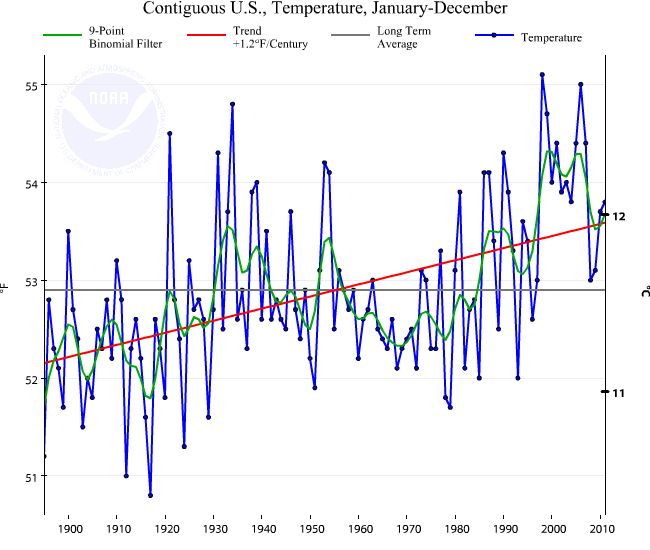Status and Trends of United States (US) Temperatures Since
1895 (Latest
Month)
This is for the latest 12 months, compared to the
same perods in each year. It is not year-to-date compared to other whole years,
but rather 12 months ending one month compared to that same period since records
began. December 2011 was 1.5 degrees F (.9 degrees C) above
the 1901-2000 average.. (Source: NOAA's
National Climate Data Center)

Analysis: The US temperature has retreated
to the 20th century average. It stands at 2 deg F (.9 deg C) below the
1934 high. If we use a 75 year record, we can argue that there is rapid
cooling, just as as strongly as those who use a 30 year or 50 year record
to promote warming. If the advent of thermometers
in the late 1800s had not coincided with the end of the last Little Ice
Age, there likely would be far less evidence of any warming at all.
The projected temperature rise by IPCC is unrealistic, given that the USA and global temperatures have risen by only 1 deg F (.5 C) in 100 years (revised, NOAA, 1 May 2007 ), (or 150 years using the full instrumented data set) during the height of industrial expansion. Even if all this rise is correct, and is attributable to human causes, it is a trivial amount in the natural variation of the Earth, and to suggest the rise would accelerate 5 fold (IPCC best estimate) in this century is incredible. Even after the release of the new data set and procedures by NOAA, which addressed some of the urban heat island issues and dropped the warming 44% (below IPCC 2007), significant other urban heat island issues still remain. There are also issues of calibration as measurement protocols have changed, issues about the design and placement of the temperature stations, and even the strongly held view by many skeptics that this is a natural rise as the Earth recovers from the Little Ice Age (circa 1500-1900). If the city where you live has a higher temperature than its suburbs, you can imagine the impact of growth around the world on land-based temperatures. The USA has fixed many of these problems. This is likely why the global temperatures rise while those of the USA are more "normal".
This page updated or reviewed in February 2012